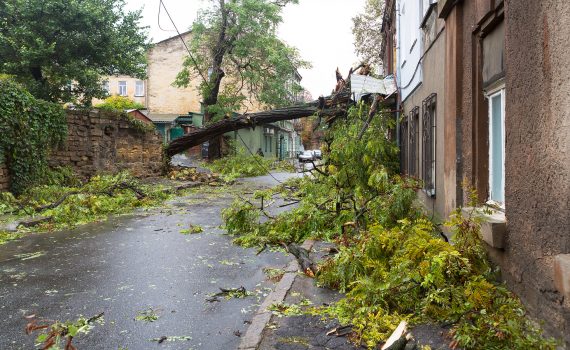Rain storms can be both positive and detrimental for trees. On one hand, rain storms provide essential water to feed and fuel trees while the force of storm winds also strengthens trees and their roots. But similarly, the power of storms can damage trees, stripping them of leaves and branches, and even completely uprooting them. This becomes a major concern when large trees are growing in close proximity to dwellings or businesses. Understanding the effect of storms on trees is important for both home and business owners, as well as landscapers and professional arborists. This understanding can not only allow us to protect trees from storms and prevent storm damage, but also helps us to make the most of the benefits of rain storms on trees.
The Benefits of Rain Storms
Rain storms don’t have only negative effects on trees. Rain storms are also very beneficial for trees. Tree root systems are uniquely designed to hold large volumes of water if necessary, acting as reservoirs for storm water that helps to reduce flooding. This also acts as a source of water and nourishment for the trees when water supplies are low.
Rain storms usually include strong winds as well, and these can provide a beneficial effect for trees. Occasional strong winds help to strengthen trees and provide reinforced root systems to prevent trees bending, breaking or being uprooted. Research has shown that trees will specifically grow stronger in one direction to protect themselves from strong winds that consistently approach from one side.
How Rain Storms Can Negatively Affect Trees
Of course, the negative effects of rain storms on trees are often clearly seen in the aftermath of rough weather. Fallen branches, cracked, broken and split trunks, and completely uprooted trees can frequently be seen after bad storms. Rain storms can cause property damage for houses and businesses when trees fall on buildings, or branches go through windows. The stripping of leaves and branches from trees can also result in costly clean-up and to maintain the safety of outdoor areas.
How To Manage Storm Damaged Trees
If you have a storm damaged tree on your property, it’s important to control the damage as soon as possible. For minor issues, such as fallen branches and leaves, a simple clean up should eliminate the hazards on the ground, and regular tree care should help your tree recover.
However, more severe or complicated tree damage such as split or cracked trees or uprooted trees may require the work on an arborist to correct. A skilled arborist can prune your tree or remove your tree to control damage and remove hazards. Stump grinding can help to remove traces of a fallen tree and allow you the opportunity to regenerate your garden and replace the tree. It’s best to remove fallen or dead trees promptly, as they can rot or act as reservoirs for pests and disease if left fallen.
How To Prevent Tree Storm Damage
Regular tree care and arborist service helps to keep trees strong and healthy, and reduce the impacts of storm damage. Corrective pruning can eliminate issues as soon as they start, while cabling and bracing can protect weak branches. It’s important to pay close attention to dead or diseased trees, as these trees can be more likely to fall in the event of a rain storm.
By monitoring and correctly pruning the trees on your property, you can avoid tree and property damage, and allow your trees to take advantage of rain storms with less of the drawbacks.
 Bringing Sexy Back Into Your Yards
Bringing Sexy Back Into Your Yards 
